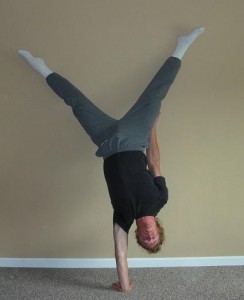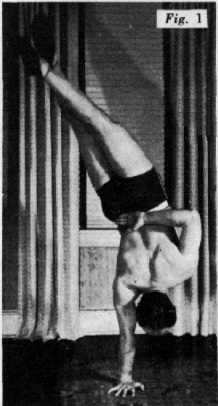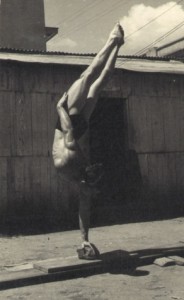Rudi Macaggi a performing acrobat and comedian demonstrates his hand balancing ability by doing a one arm handstand on a guitar.
Don’t try this at home without many years of practice. You could hurt yourself and the guitar!
Rudi Macaggi a performing acrobat and comedian demonstrates his hand balancing ability by doing a one arm handstand on a guitar.
Don’t try this at home without many years of practice. You could hurt yourself and the guitar!
This is the second in the series on progress towards the one arm handstand series.
In the Secrets of the Handstand Quick Start Video I show four lead-up stunts that work the skills necessary to do a handstand.
The one arm handstand has lead-up stunts too.
 As was discussed previously in part 1, the most important lead-up stunt is to build a stable and consistent handstand that you can hold with ease. Only once you are at this point should you begin work towards that one arm version.
As was discussed previously in part 1, the most important lead-up stunt is to build a stable and consistent handstand that you can hold with ease. Only once you are at this point should you begin work towards that one arm version.
Just like for the regular handstand, a handstand against the wall can be used. In using it to lead-up to the one arm handstand, you’ll obviously do it on one arm.
This can help to build your strength. Plus you’ll be able to work on your position, to make sure you get exactly as you want. This is excellent as I find in my practice that as I fatigue it becomes harder to stay in the locked out position. Much easier to work on building this up without focusing on balancing, by using the wall. With a stronger position you will be able to practice longer and more.
When you do that one arm handstand against the wall you should do it in the same form as you’ll be working on the balance. If your legs are spread, do it legs spread. If you’re working on the one hander with legs together, do that against the wall. Try to minimize your lean as much as possible as you strive for the best position.
Being able to hold the one arm handstand against the wall for 45 seconds to a minute is a good goal to shoot for. This is one important step in the journey towards success.
Good Luck and Good Hand Balancing,
Logan Christopher
P.S. Want more help for the one arm handstand? Be sure to check out How to do the One Hand Handstand by Professor Orlick.
My current goal in hand balancing is to do the one arm handstand. Its been a goal for a long time.
On that note I’m going to start a new series of articles that detail my progress toward it. This series will be off and on as I try new exercises, have breakthrough’s and make progress. There will be no known end point and no regular schedule to these, but they‘ll come when they come.
Before I get to that though we need to start with the preliminaries.
Where should you be at in your hand balancing practice before you begin in the one arm handstand?

Bob Jones in a One Arm Handstand
Bob Jones from The True Art and Science of Hand Balancing says:
“He who cannot walk can hardly run, and it is equally true that one who cannot do a correct two hands balance can hardly hope to master the balance on one hand. And by this term I do not mean mere ability to stand on the two hands; I mean the ability to stand in good position and to remain there by balancing correctly. So, before making a pass as the one-hander, check back on your two hands position.
“The position on two hands must be with arms straight and perpendicular when viewed from the side. Use all your back bend-whether much or little does not make too much difference, but use all of it until you learn the balance; then you can stiffen up if desired. Go over Chapter 7 and check your position to make certain you balance correctly in the proper position; weight on the ball of the hand, balance by wrist action (imagine that you are balancing on one hand on a silver dollar placed underneath the first two knuckles), and not by wiggling or shimmying the legs from knees, hips, or small of back. If you feel satisfied, let us proceed.”
And from Professor Orlick in How to do the One Hand Handstand:
“YOU MUST FIRST MASTER THE TWO-HAND HANDSTAND. That’s right! You cannot possibly do a good One-Hand Handstand until you can do a perfect Two-Hand Handstand.
“This does not mean that you must be able to perform all of the hundreds of tricks in my basic course “Handbalancing Made Easy”. It simply means that you must be able to press into a perfect Two-Hand Handstand and hold it with absolute control. It means that your elbows must be straight and locked, that your shoulders must be stretched out and locked, that your back must be only slightly arched, your knees perfectly straight and your toes pointed.
“When your shoulders are fully stretched out, you shoulder muscles (deltoids) should actually be pressing against your ears. Furthermore, there should be a straight bone-to-bone alignment at your elbow and shoulder joints so that no strength is needed to support your bodyweight. When you get into this fully locked-out position, with every part of your body stiffened out into a straight line from your hands to the very tip of your toes, then you will be able to hold the Perfect Two-Hand Handstand with practically no effort whatsoever. In fact, all that it will require to keep you up there is the slightest bit of pressure against the floor with your fingertips.
“The fully locked-out position in the two-hand handstand, is the half-way mark to the One-Hand Handstand. This is the position you must assume every time you want to go into the One-Hand Handstand. In fact, this is so close to the One-Hand Handstand that you can’t get much closer to it without actually doing it.
“YOU should practice the perfect Two-Hand Handstand until you have absolute control of it before going on to the One-Hand Handstand. You can figure that you have reached this point when you can hold a fully locked-out two-hand handstand consistently for about 45 seconds. Most good handbalancers can hold it twice this long so you should keep on practicing until at least one minute is well within your capability.”
While there is disagreement about the back-bend the rest of the details are similar. Before beginning the one arm handstand you need to be able to hold a handstand with ease in good position.
If you can’t do this, your efforts towards the one arm handstand are going to result in nothing but frustration.
This is getting me excited to work on my position more right now.
Next time we’ll look at some other important lead-up stunts before beginning in earnest with the one armer itself.
Good Luck and Good Hand Balancing,
Logan Christopher
Just the other day I received this amazing story from a professional hand balancer by the name of Jonathan Ferland-Valois.
I can’t vouch for the accuracy of the story but that doesn’t make it any less of a good story. And I do hope its true.
Hi! I heard a story you might find very interesting. I work in a circus, I’m an acrobat that trains in hand balancing, aerial straps, and strength stuff (per example, I’m working hard on my one arm handstand push-up). I already talked with you like one year ago, when I was still in Montréal (I told you I was an ex-gymnast). Today, I was training with other performers for a show we’ll have soon, and one of them told me that cool story:
 One of his friends, a good hand balancer, went in China, where he wanted to train with a master of hand balancing. That master was in his 60’s. The student showed him his one arm handstand, which was already very good and solid. The master went in handstand right beside him, then he used one of his hands to slap him, telling him to do better. The student tried to correct his position, and then the master stayed in one-arm handstand, and started pushing him with his free hand, saying: “You’re not enough stable.” The student felt back in a regular handstand, but the master kept pushing him with his free hand, telling him he wasn’t stable, until the student just fell on his back. All the time, the master stayed in one arm handstand, pushing and slapping the student.
One of his friends, a good hand balancer, went in China, where he wanted to train with a master of hand balancing. That master was in his 60’s. The student showed him his one arm handstand, which was already very good and solid. The master went in handstand right beside him, then he used one of his hands to slap him, telling him to do better. The student tried to correct his position, and then the master stayed in one-arm handstand, and started pushing him with his free hand, saying: “You’re not enough stable.” The student felt back in a regular handstand, but the master kept pushing him with his free hand, telling him he wasn’t stable, until the student just fell on his back. All the time, the master stayed in one arm handstand, pushing and slapping the student.
When the student (the performer’s friend) came back, he had crazy good hand balancing. And his numero was absolutely incredible. There was a 8 foot high stand, with handbalancing canes on it. To go on the stand, there was pegs, climbing with about a 45 degrees angle. Do you know how the guys was going on the stand? Not climbing the pegs on his hands, it would have been too easy. He was doing it in Thomas flares! And another crazy trick he had in his routine was a one arm back handspring, stopping in one arm handstand. That’s nuts, isn’t?
So, I asked my friend to find a video of that. Cause I really, really want to see. If I ever get the video, I’ll ask their permission to send it to you. Cause you already know very good western hand balancer. But maybe there’s a couple of very crazy hand balancers from far east that you’d like to know about! Anyway, now I want to go train in China, ha ha! And I’ll probably do it not this summer, but at the end of the next summer.
Good training, for pulling that firetruck!
Thanks for sending that in and I hope you get a hold of that video.
Good Luck and Good Hand Balancing,
Logan Christopher
When talking to Jim Bathurst the other night we we’re discussing the one arm handstand. Several points came up but I want to focus on one of them right now. And this actually applies to any hand balancing you do.
That point is shrugging up your shoulders.
When you go into a handstand you want to reach your shoulders towards your ears. Do not let gravity depress your shoulders. Why? This makes it so that your body is fully locked out. This improves your position as well as your endurance.
This is even more essential in the one arm handstand. But here’s the thing. Some people may not even have the strength in the shoulder girdle and scapula to do it properly.
As is many times the case in hand balancing it’s a good idea to go back to the wall for this one. Doing the one arm handstand against the wall, where you don’t need to worry so much about balance, you can focus on getting the shoulder shrugged.
In The Ultimate Guide to Handstand Pushups there’s an exercise called the Handstand Shrug. This is just to repeat this shrugging motion over an over for reps. While I didn’t think about it at the time, you could do this exact same exercise on just one arm. (I just tried it against and found it to be quite fun.)
This will strengthen the area, giving you the strength to really begin to progress toward the one arm handstand.
Good Luck and Good Hand Balancing,
Logan Christopher
© 2024 Lost Art of Hand Balancing. All Rights Reserved.
Powered by WordPress. Designed by ![]()
